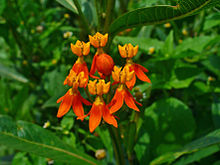- Asclepias curassavica
-
Asclepias curassavica Scientific classification Kingdom: Plantae (unranked): Angiosperms (unranked): Eudicots (unranked): Asterids Order: Gentianales Family: Apocynaceae Genus: Asclepias Species: A. curassavica Binomial name Asclepias curassavica
L.Asclepias curassavica, commonly called Mexican Butterfly Weed, Blood-flower, Scarlet Milkweed or, Tropical Milkweed, is a species of flowering plant in the dogbane family, Apocynaceae. It is native to the American tropics.
It has a pantropical distribution as an introduced species. It is grown as an ornamental garden plant and as a source of food for butterflies.
Contents
Description
Typical plants are evergreen perennial subshrubs that grow up to 1 m (3.3 ft) tall and have pale gray stems. The leaves are arranged oppositely on the stems and are lanceolate or oblong-lanceolate shaped ending in acuminate or acute tips. Like other members of the genus, the sap is milky. The flowers are in cymes with 10-20 flowers each. They have purple or red corollas and corona lobes that are yellow or orange. Flowering occurs nearly year round.[1] The 5–10 cm (2.0–3.9 in) long, fusiform shaped fruits are called follicles. The follicles contain tan to brown seeds that are ovate in shape and 6–7 mm (0.24–0.28 in) long. The flat seeds have silky hairs that allow the seeds to float on air currents when the pod-like follicles dehisce (split open).[2]
Cultivation
There are a number of different cultivars with improved flower colors and shorter habit, some have brilliant red, yellow or orange colored flowers. Asclepias curassavica is excellent in butterfly gardens or as a cut flower. However, when the stems or leaves are broken, a poisonous milky sap extrudes which can cause eye injury.[3]
Gallery
-
Monarch caterpillars feeding on Milkweed.
References
- ^ http://www.efloras.org/florataxon.aspx?flora_id=2&taxon_id=200018502
- ^ http://www.floridata.com/ref/A/ascl_cur.cfm
- ^ Hsueh KF, Lin PY, Lee SM, Hsieh CF (February 2004). "Ocular injuries from plant sap of genera Euphorbia and Dieffenbachia". J Chin Med Assoc 67 (2): 93–8. PMID 15146906. http://homepage.vghtpe.gov.tw/~jcma/67/2/93.pdf.
External links

This Apocynaceae article is a stub. You can help Wikipedia by expanding it.









